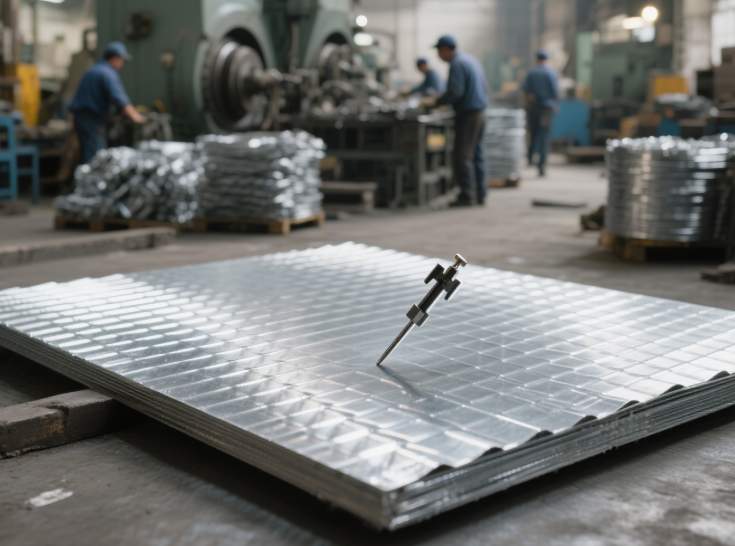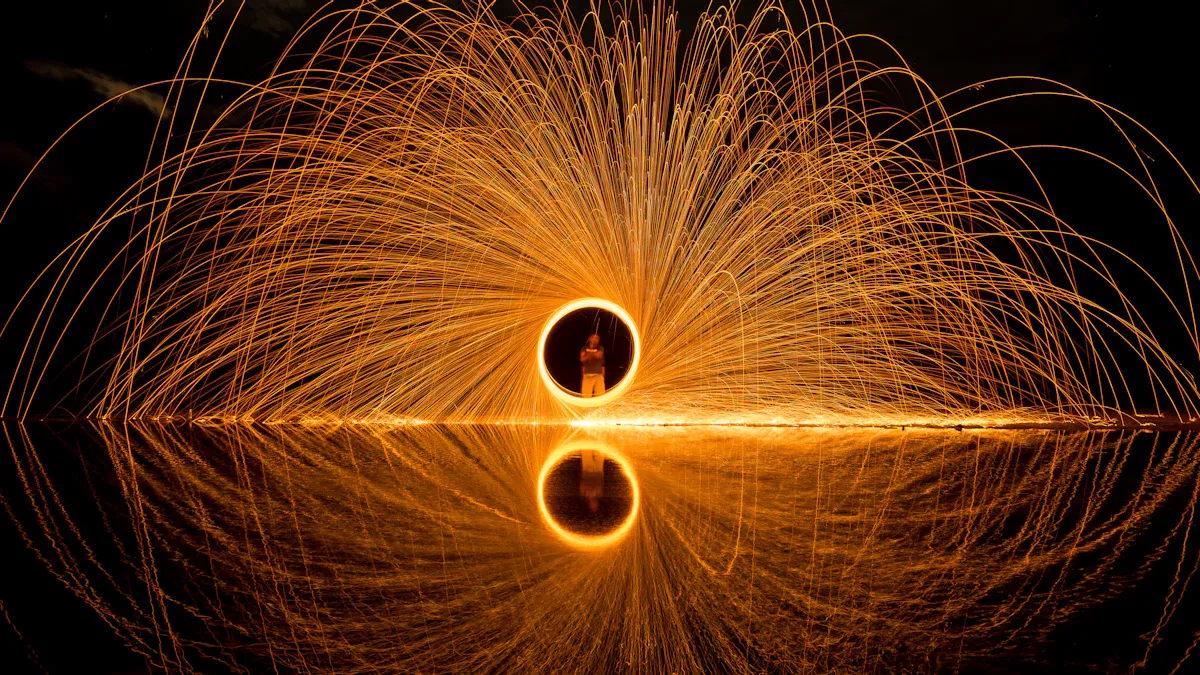Yes, galvanised steel is magnetic. The steel core inside gives it magnetic properties. The zinc coating on the surface does not block magnetism. You might notice that the magnetic pull feels a bit weaker compared to bare steel. This happens because the zinc layer adds a small barrier. If you use magnets for construction or storage, this detail can help you choose the right material.
Tip: Always test your magnet on galvanised steel if you need a strong hold.
Key Information
- Galvanised steel is magnetic because it has iron inside. Iron attracts magnets a lot. The zinc coating on galvanised steel stops rust. But the zinc makes the magnet pull a little weaker at the top. If the zinc layer is thin, the magnet is stronger. If the zinc layer is thick, it stops rust better but makes the magnet weaker. Galvanised steel usually holds magnets better than most stainless steels. This makes it good for things that need magnets. Always try magnets on galvanised steel before you use them. This is important if you need a strong hold or use heat and chemicals.
Galvanised Steel and Magnetism

Steel Core Properties
Galvanised steel is strong and also magnetic. The inside part is made from mild steel. Mild steel has a lot of iron in it. Iron makes the steel magnetic. Magnets stick to it easily. The iron atoms line up and make a strong magnetic field.
You can see how different metals act with magnets in this table:
| Material Type | Magnetic Properties | Rust Resistance |
|---|---|---|
| Steel Core in Galvanized Steel | Strongly ferromagnetic because of iron; magnetic but a little weaker because the zinc coating gets in the way | Yes, the zinc coating stops rust |
| Plain Carbon Steel | Very magnetic (lots of iron) | No rust protection unless coated |
| Zinc Coating Only | Not magnetic | Yes, stops rust |
| Stainless Steel | Usually not magnetic or just a little magnetic (because chromium and nickel change it) | Yes, does not rust easily |
The steel core is like plain carbon steel but has a zinc cover. The core stays magnetic because it still has iron. Magnets stick to galvanised steel, just like they do to plain steel. The pull might feel a little weaker because of the zinc.
- The steel core is usually mild steel, which is magnetic.
- Mild steel has less carbon than high-carbon steel, so it is a bit less magnetic.
- The core keeps being magnetic even after it gets galvanised.
Zinc Coating on Galvanised Steel
The zinc coating keeps the steel from rusting, but it does not stop magnetism. Zinc is not magnetic. It cannot be magnetized and does not attract magnets. The zinc layer is very thin, about 50 to 150 microns thick. This thin layer does not block the magnetic field from the steel inside.
Note: The zinc coating can make the magnetic pull feel a little weaker. This is because the zinc makes a small barrier, so the magnetic field is not as strong at the surface.
- Zinc is diamagnetic, so it is weakly pushed away by magnets.
- The thin zinc layer does not change the steel’s magnetism.
- Tests show that magnets still stick to galvanised steel, even with the zinc.
When you use a magnet on galvanised steel, it will stick. Sometimes it does not stick as strongly as it does to plain steel. The difference is small, but it matters if you need a really strong hold.
Zinc Coating Effects
Magnetic Strength
When you test a magnet on galvanised steel, you may notice that the pull feels weaker than on plain steel. The reason comes from the zinc coating. The thickness of this zinc layer usually ranges from about 1.4 to 3.9 mils (35 to 100 microns). Thicker coatings give better rust protection, but they also make the magnetic pull at the surface weaker. As the zinc layer gets thicker, the magnet has to work harder to reach the steel core underneath. This means the magnetic attraction drops as the zinc coating increases.
Manufacturers use special tools to check the thickness of the zinc layer. These tools, called magnetic gauges, measure how much force it takes to pull a magnet from the surface. You can see the relationship in this table:
| Zinc Layer Thickness | Magnetic Pull at Surface | Rust Protection |
|---|---|---|
| Thin | Stronger | Lower |
| Thick | Weaker | Higher |
Note: The magnetic pull you feel on the surface does not show the true strength of the steel core. The zinc only acts as a barrier.
Surface vs. Core
You might wonder if the steel inside still keeps its magnetic power. The answer is yes. The steel core stays magnetic, even with a zinc coating. The surface, however, feels less magnetic because the zinc blocks some of the magnetic field. If you could measure the magnetic field inside the steel, you would find it much stronger than at the surface.
- The zinc layer is not magnetic, so it shields the steel core’s magnetic field.
- A thin zinc layer lets more magnetism through, while a thick layer blocks more.
- The core always has stronger magnetism than the surface.
Manufacturers check the zinc coating using magnetic induction devices. These devices help make sure the coating is even and meets industry standards like ASTM and ISO. They do not measure magnetic strength directly, but they use the magnetic principle to test the coating.
Tip: If you need a strong magnetic hold, choose galvanised steel with a thinner zinc layer, but remember that thicker coatings protect better against rust.
Galvanised Steel vs. Stainless Steel

Magnetic Differences
You might want to know how galvanised steel and stainless steel compare with magnets. The answer depends on which stainless steel you have. Here are some important things to know:
- Austenitic stainless steel, like 304 and 316, is usually not magnetic. You see this kind in kitchen sinks and machines.
- Ferritic stainless steel is magnetic. Car companies use it for car exhausts.
- Martensitic stainless steel is also magnetic. It is used for tools and knives.
- Duplex stainless steel mixes austenitic and ferritic types. It can be magnetic but is harder to shape.
- Galvanised steel is always magnetic because it has a steel core under the zinc.
If you try a magnet, it will stick to galvanised steel. It might not stick to most stainless steel, unless it is ferritic or martensitic. Even then, the magnetic pull can feel different. Bending or twisting some stainless steels can make them a bit more magnetic, but not as much as galvanised steel.
Tip: If you want a strong magnet hold, galvanised steel is usually better than most stainless steels.
Application Choices
When you pick between galvanised steel and stainless steel for magnets, think about more than just magnetism. Here are some things to keep in mind:
- Galvanised steel gives strong magnetism and good rust protection from the zinc.
- It is tough and keeps things clean.
- Welding galvanised steel is hard. The zinc can make welding tricky, so you may need bolts or rivets.
- Some very big or very small things cannot be galvanised.
- Stainless steel does not rust easily, but most types do not attract magnets. Only ferritic and martensitic types work for magnets.
If you want both rust protection and strong magnetism, galvanised steel is often the best choice. If you need to weld or want a non-magnetic material, stainless steel might be better.
| Feature | Galvanised Steel | Stainless Steel (Austenitic) | Stainless Steel (Ferritic/Martensitic) |
|---|---|---|---|
| Magnetic? | Yes | No | Yes |
| Rust Resistant? | Yes | Yes | Yes |
| Easy to Weld? | No | Yes | Yes |
| Best for Magnets? | Yes | No | Sometimes |
Misconceptions
Zinc Layer Myths
Some people think the zinc layer stops magnetism. This is not correct. The zinc does not keep magnets from sticking to steel. The magnetic pull feels weaker, but the steel still attracts magnets. The zinc is just a thin barrier. It does not take away the magnetic field.
Others believe the zinc makes steel better for magnets. That is not true. A thicker zinc layer makes the magnetic pull weaker at the surface. If you use a strong magnet, you may not see much change. With small magnets, you will notice the difference.
Note: The zinc keeps steel from rusting, but it does not make magnets work better.
Suitability for Magnets
You may wonder if galvanized steel is always best for magnets. The answer depends on what you need. Here are some things to think about:
- The zinc layer makes the magnetic pull weaker, especially if it is thick.
- High heat can make galvanized steel lose its magnetism.
- Chemicals can also make the steel less magnetic.
- Galvanized steel is not as strong as pure iron or low-carbon steel for magnets.
- If you need a very strong magnet, you might want another material.
You should test your magnets before you start your project. If you need a strong hold, try plain steel or a magnetic stainless steel. Galvanized steel works for many jobs, but it does not work well in high heat or with lots of chemicals.
Tip: If you want a strong magnet hold, check the zinc layer. Thinner zinc lets more magnetism through.
Steel keeps its magnetic power even after it is galvanized. The zinc coating does not stop the steel from being magnetic. It can make the magnet feel a little weaker on the outside. Experts say the zinc only helps stop rust and does not change the steel inside. In building work, you can use magnets to clean up and work with strong, rust-free steel. Pick the right zinc thickness and follow rules to get both good magnetism and rust protection.
FAQ
Does the zinc coating on galvanized steel wear off over time?
Yes, the zinc coating can wear off if you scratch or rub the surface a lot. If you see bare steel, rust may start. You should check your steel often if you use it outside.
Can you paint over galvanized steel?
You can paint over galvanized steel. Clean the surface first. Use a primer made for galvanized metal. This helps the paint stick better and last longer.
Will magnets damage the zinc coating?
Magnets do not damage the zinc coating by themselves. If you slide a strong magnet across the surface many times, you might scratch the zinc. Try to lift magnets off instead of dragging them.
Is galvanized steel safe for food contact?
Galvanized steel is not safe for direct food contact. The zinc can react with acidic foods. You should use stainless steel or food-safe coatings for anything that touches food.

